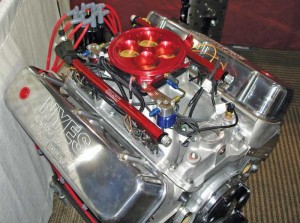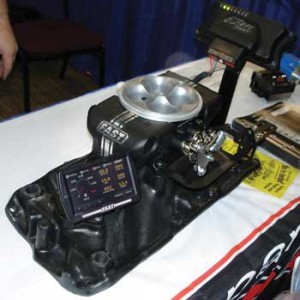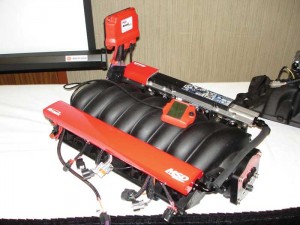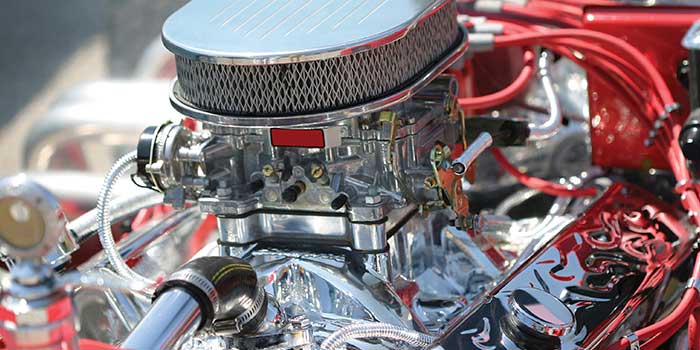If you’re building a performance engine, should you fuel it with a carburetor or some type of electronic fuel injection (EFI) system? If the application is a late-model vehicle that came factory-equipped with EFI, that decision has already been made for you.
But if you’re building an engine for a restorod, street rod, muscle car or some type of race car, you can go either way. If you’re open to the idea of upgrading to EFI instead of a carburetor, there are a variety of aftermarket EFI systems from which you can choose. Your only limitations are how much you (or your customer) can afford to spend, and any rules that would prohibit the use of EFI in a particular racing class.
Bolt-on aftermarket EFI throttle body systems have become a popular upgrade for many street performance applications that have traditionally been fueled with a square flanged four barrel carburetor. A number of companies now offer TBI systems that are relatively easy to install, self-tuning and require no special computer skills to get up and running.
As far as the automakers are concerned, the battle between carburetors and fuel injection was decided back in the 1980s when throttle body injection (TBI), then multi-port injection (MPI), replaced carburetors on new vehicles. The automakers went to fuel injection for a number of reasons: to meet tougher emission requirements, improve fuel economy, cold-start driveability and performance.
Even NASCAR has moved into the 21st century with EFI. The initial move was met with a lot of resistance, but now that they’ve made the transition, nobody would ever go back. Most circle track racers are still running carburetors, so the NASCAR technology has not yet filtered down, but many say it is only a matter of time. Some drag racers are even converting over to EFI because it gives them better control and consistency.

Counting Carbs
A carburetor is a compromise at best, and is never in perfect tune. That’s because the air/fuel mixture changes with temperature, humidity and altitude. Consequently, you have to constantly fiddle with the jetting in a carburetor to compensate for daily changes in weather conditions. Close enough is good enough for most street cars, but not if you want to be competitive on a race track.
A carburetor also has to be capable of altering the air/fuel ratio depending on operating conditions. A cold engine needs a very rich fuel mixture to start. This is handled by a manual or automatic choke. Getting the choke set right so it is neither too rich or too lean is the key to easy cold starting and cold driveability. The fuel mixture also has to be gradually leaned out as the engine warms up, so the choke must open at just the right rate otherwise the engine may bog or stall.
Cold driveability with a carburetor can be a real problem if the stock air cleaner heat riser plumbing has been replaced with an open-style air cleaner and/or the heat crossover passage under the carburetor plenum in the intake manifold has been blocked off or eliminated. Colder incoming air is denser air that makes more power. But too much cold when a cold engine is first started reduces fuel atomization and typically makes the fuel mixture too lean, causing the engine to stumble and stall until it warms up.
 A cold engine needs a higher idle speed while it is warming up. The choke linkage also controls this function. This requires careful adjustment of the fast idle and base idle speed screws. If the screws are misadjusted, or the opening rate of the choke isn’t perfect, the engine may race (idle too fast) or stall.
A cold engine needs a higher idle speed while it is warming up. The choke linkage also controls this function. This requires careful adjustment of the fast idle and base idle speed screws. If the screws are misadjusted, or the opening rate of the choke isn’t perfect, the engine may race (idle too fast) or stall.
The idle mixture also has to be adjusted just right so the engine doesn’t idle too rich or too lean. This requires playing with the idle mixture adjustment screws. What’s more, the idle mixture can also be affected by the height of the float(s) inside the fuel bowl(s).
When the petal goes to the metal, a carburetor will bog unless the accelerator pump provides an extra squirt of fuel. This too requires fiddling to get just the right shot of fuel so it’s not too rich or too lean. A power valve inside the carburetor also allows more fuel flow through the main metering circuit when the engine is pulling hard under load. This is necessary to provide maximum power (a rich air/fuel mixture) and to prevent the air/fuel mixture from going lean, which could result in preignition or detonation.
Carburetor tuning is often a trial-and-error process that requires a lot of fiddling until the engine runs best – and even then, it won’t be perfect once the ambient temperature changes.
Other changes and add-ons can also mess up a carburetor tune. Opening up the exhaust headers, installing different mufflers, even changing the final drive axle ratio or tire size can all affect a carburetor.
So why are many racers still using carburetors? Because they are familiar with carburetors and because carburetors seem simpler (no electronics).
Carburetors also have a cost advantage compared to EFI. The typical bolt-on TBI fuel injection system will cost around $2,500 to $2,700, which may or may not include an electric fuel pump and additional plumbing. By comparison, you can buy a brand-new street performance carburetor from $300 to $800, or a big bore racing carburetor for $800 to $1,400 or more. Add extra $$ if you want the carburetor hand built, reworked, power coated, plated or modified for methanol or E85.
Bolt-On TBI
Compared to a carburetor, a bolt-on TBI system is like night and day. For one thing, fuel injection depends much less on intake vacuum than a carburetor. A wild cam is great for high rpm power, but it also kills intake vacuum and low speed torque and throttle response. Consequently, if an engine has a long duration cam, that bumpty-bumpty-bump idle that sounds so cool may make the vehicle tricky to drive on the street – especially when the engine is cold.
TBI fuel injection sprays fuel into the throttle body, whereas a carburetor relies on an intake vacuum to pull fuel from the fuel bowl through the metering circuits into the air stream. So most TBI systems can tolerate radical cams with durations up to about 250° with much more finesse than a carburetor. The engine will run smoother, idle better, start easier and provide better throttle response and cold driveability with TBI than a carburetor.
Idle speed is not controlled by an adjustment screw on the throttle linkage, but by an idle air control bypass valve operated by a solenoid or electric motor and the controller. On most of the bolt-on TBI systems, the throttle is still mechanical and connects the same as a carburetor with a cable or linkage and return spring.
A TBI system uses closed loop feedback fuel control to constantly fine-tune the air/fuel mixture. The TBI controller looks at the O2 sensor signals to see if the engine is running rich or lean, then compensates by adding or subtracting fuel as needed to balance the fuel mixture. This is done by increasing or decreasing the on-time (duty-cycle) of the fuel injectors. This approach saves fuel when extra fuel isn’t needed (as when cruising or decelerating), makes the engine run cleaner (lower emissions), and makes for a much smoother running engine. This can make many vehicles much more enjoyable and practical for everyday driving.
The controller can also compensate for changes in temperature and altitude that change air density. So the engine is always in tune regardless of what the weather is doing. That’s a huge advantage over a carburetor with fixed jetting.
There is also less danger of “over-carbureting” an engine with a TBI system. For a carburetor to perform well, its cubic feet per minute (cfm) rating has to match the engine’s displacement and breathing characteristics. A bigger carb that flows more air can make more power at higher rpms, but if the carburetor is too big, it won’t respond well at lower rpms, which hurts throttle response and low-speed torque. A typical street performance small block Chevy can usually handle a 600-750 cfm carburetor. By comparison, most of the bolt-on TBI systems have a throttle body that flows up to 930 cfm – which means it can be installed on almost any engine that is capable of making 250 up to 600 or more hp. That’s a lot of latitude from a “one-size-fits-all” throttle body.
A TBI system won’t necessarily make more horsepower than a carburetor. Some engine builders have reported a slight gain in power (up to 20 hp or more) when going from a carburetor to a bolt-on TBI system (which may be the result of better tuning) while others report little or no significant difference. Even so, a TBI system will start, idle, run and respond much better than a carburetor, and will maintain a near perfect tune over a much broader range of temperatures and operating conditions.
The only limitation of a TBI system is that it has the same fuel distribution and fuel separation issues as a carburetor on a single 4BBL manifold. The different lengths of the intake runners and their curvature typically causes the center cylinders in a V8 engine to run richer than the end cylinders. Multi-port EFI systems are much better in this respect because they usually equalize fuel distribution much better. Multi-port EFI systems also have a dry intake manifold (no air/fuel mixture to separate going around corners) because they spray fuel directly into the cylinder head intake ports. Consequently, a sequential multi-port EFI system is often capable of making more power than a TBI system or carburetor.
Component Connection
The bolt-on TBI systems are engineered to replace a standard square flange 4BBL carburetor, so you can use the same intake manifold as before. Just remove the carburetor and bolt-on the TBI unit. If the intake manifold is for a spread bore carburetor or Quadrajet, an adapter plate will be needed to install the TBI.
Most of the basic bolt-on TBI systems have a compact control module that mounts on the throttle body. This makes for a nice, clean installation without a lot of wires. A throttle position sensor and manifold absolute pressure sensor are built into the throttle body to monitor throttle position and intake vacuum. The controller uses this information as well as engine rpm to calculate airflow. These are “speed-density” systems that don’t need an expensive (and sometimes troublesome) mass airflow sensor to measure airflow into the engine.
The wiring harness that comes with these bolt-on TBI systems makes installation a snap. The wiring harness usually connects the controller on the TBI to an external power box that provides power for the controller, injectors and electric cooling fans (if used), and electric fuel pump (required). The harness connects the controller to an engine coolant sensor (for monitoring engine temperature), a crank position sensor or the distributor (for ignition triggering and timing, and sequential firing of the fuel injectors), and a pair of wideband oxygen sensors mounted in the exhaust to monitor the air/fuel mixture. Installing the O2 sensors does require some drilling and welding, but the bungs for mounting the sensors in the exhaust header collectors are not that hard to install.
Fuel system modifications are also required when converting from a carburetor to a TBI or any other type of EFI system. The mechanical pump has to be replaced with an inline high pressure electric fuel pump, pressure regulator and filter. The pump has to meet the flow and pressure requirement of the system. Most TBI systems can be setup with either a return fuel line to route excess fuel from the regulator back to the fuel tank, or a returnless fuel setup (no return line). A returnless installation may seem easier, but it also increases the risk of fuel line vapor lock during hot weather.

Self-Tuning
The “self-tuning” capabilities of these bolt-on TBI systems are what really set them apart from a carburetor or a more sophisticated full race EFI system. The controller comes preloaded with calibrations that can accommodate a wide range of applications. No laptop is required to input data or to tune the system because the package includes a simple handheld tuner that you use to enter the initial setup information. The controller needs to know engine displacement (in cubic inches or liters), camshaft duration (in degrees), the rpm where you want to set the rev limiter, the ignition setup and any other info that may be requested on the setup menu. You then start the engine and let the controller do the rest.
As the engine and oxygen sensors warm up, the controller will go into closed loop feedback fuel control. It will start adjusting the fuel mixture using the O2 sensor inputs. As the vehicle is driven, the controller will continue to learn the fuel settings as it fine-tunes all of its calibrations. It typically takes a day or two of driving before everything is totally dialed in. You want to do some mild and hard acceleration, braking and cruising so the computer can develop the best fuel map for the engine.
On the more sophisticated racing EFI systems, which may be TBI or multi-port, special tuning software and a laptop are usually required to enter a much longer list of setup variables and operating perimeters. The more sophisticated EFI systems have multiple inputs and outputs and are fully customizable. Many of the high-end EFI systems also have self-tuning capability, and can develop a fairly close fuel map with only one or two dyno pulls.
According to one supplier, the best fuel map is one that is smooth from the low end to peak rpm, without a lot of humps or peaks. When viewed as a 3-D graph, the fuel map should look more like a twisted sheet than a downhill snowboard course. You can always tweak the fuel mixture or ignition curves at specific points with the laptop programming software, but some of these systems do such a good job of self-tuning that additional tweaks are unnecessary.
Retrofits
If you want to install a late-model Chevy LS engine, Ford module V8 or Chrysler Hemi into an older vehicle, aftermarket bolt-on EFI conversion kits are available for many of these applications. Like the bolt-on TBI systems, these typically include a compact controller and custom wiring harness that can be easily installed and connected to the vehicle’s electrical system. The “plug-and-play” approach is much faster and easier than trying to use a factory PCM and modified OEM wiring harness when doing a retrofit engine installation on an older vehicle.
The advantages of these systems are the same as TBI: better cold starting, smoother idling, better driveability, fuel economy, throttle response and easier tuning compared to a carburetor.














